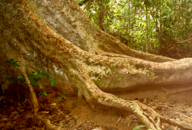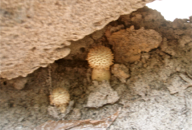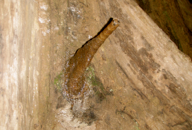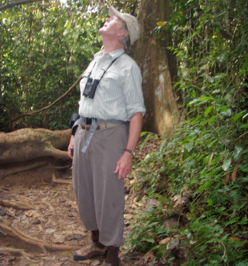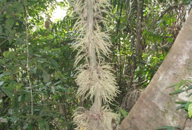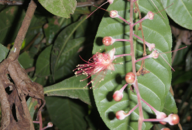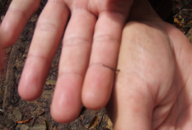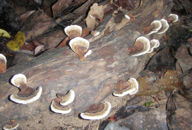trEK to bukit teresek
taman negara national park
state of perak, eastern & central peninsula, malaysia
March 20, 2009


trEK to bukit teresek
taman negara national park
state of perak, eastern & central peninsula, malaysia
March 20, 2009




On our first evening, Henry and I met our guide Kadri, then took a two hour walk on a well-trod trail into the forest. Using his spotlight, Kadri taught us how to see spiders in the dark by shining the light on their eyes. We used the same method to spot deer from a blind above a salt lick. Stick insects, well camouflaged amongst the leaves were abundant, as well as cicadas and grasshoppers, both making quite a racket in the dark woods. We also spotted night blooming flowers, beautiful specimens that live for only one night, dropping off when fertilization is complete. The next morning, we met Kadri at 9 AM for a jungle trek, first to the Canopy Walk, then further to a viewpoint where we could see the mountain landscape. We had been warned about leeches, since it had rained slightly the night before. Henry tucked his trousers into his socks. I did something similar, but wore my bicycle leggings to avoid any open spaces in my layer of clothing. Long sleeves were du rigeur. Fortunately, the only leech we saw was presented to us by Kadri. This was a really small specimen, one of three varieties which live in this terrain. Smaller than an inch, and two or three milliimeters thick, it is attracted to heat, especially human heat. Every time I lingered to photograph some fungi or mushrooms, Kadri would warn me against stopping too long. He knew that these leeches hid beneath damp leaves; and, if I stood in one place too long, my warmth would be discovered. This didn’t seem to scare me. Later I heard from a friend, Patrick and his wife, May Song, who both consider leeches to be the most frightening wildlife in the jungle. The reason, as he experienced is this: one leech finds you. You then put salt on it to get it to remove its dart from your skin. While you are doing that, a whole gang of leeches -- 30 or more -- join the fun. It is impossible to attend to all at once, and you are covered in these blood suckers who inject an anesthetic to desensitize the area they bite, and a anti-coagulant to be able to suck your blood. If you pull one off, the blood pours out, requiring 20 or 30 minutes to coagulate. Yikes! Fortunately, we were not prey to these creatures. Back to our hike, which was vigorous. We climbed trails with natural steps created by the roots of trees, always challenging to walk on without being tripped. Along the path, we learned more about the forest, the trees, the ecosystem, the fungi, the plants, the birds, the bees, the soil, and the flowers which bloom here. It was a rewarding day, with a view across a valley to the mountains beyond. On our walk back to the resort grounds, Kadri told us that the very trail upon which we walked was the place of the last siting of a Sumatran tigers, captured by video camera mounted near the trail. Its hunting territory is very wide, and it hasn’t been seen again for several years. However, there have been several reports in East Malaysia (on the island Borneo) of tigers attacking villages and mauling humans, a recent event being the killing three illegal poachers of trees. Henry was most impressed when we read in a local newspaper that a tiger had killed a man, devouring his heart, liver and brain. It’s unusal for tigers to attack humans, but this one was definitely a gourmet!
PHOTOS: Left Column: 1. Henry at the view from the top of Bukit Teresek. Gunung Tahan and Gunung Perlis are in the background. 2. An example of the regeneration of the forest in the new growth of leaves (red) when the older leaves drop off. There is never a change in season except wet to dry, so the trees never go into a state of hibernation. 3. Detail: a rather large army of termites, all carrying chunks of wood to their colony. 4. Large tree with buttress roots which help support its tall height. 5. A tree in flower. 6. Night blooming flower, one left overnight on the stem. These flowers drop off when fertilization is complete. Center, Top: Cross section of a tree. The trees in the tropical rain forest have no rings because they do not lose their leaves all at once, nor do they hibernate over the winter. There is no winter, so the trunk produces no record of growth, except occasional thinly etched lines that mark the rainy seasons. Center, Middle: Our trail -- the maze of roots which served as a stairway to Bukit Teresek. Center, Bottom: Henry, following the call of a bird. Right Column: 1. Peacock Fern, named for the blue-green color caused by the sun’s UV rays. 2. Large fungus growing on the trunk of a tree. 3. Tiny spiky mushrooms growing beneath a decaying tree trunk. 4. Sweat bee hive. 5. A leech! Kadri proving to us these little critters really do exist. 6. Wood mushroom or fungi, growing in the jungle.


ECOLOGICAL BALANCE




